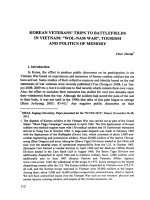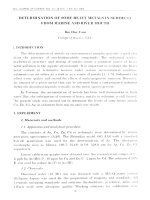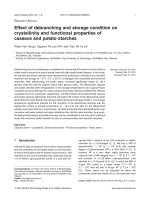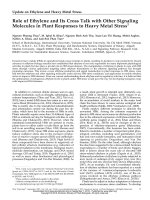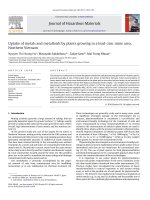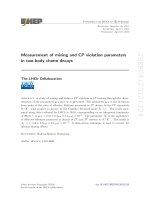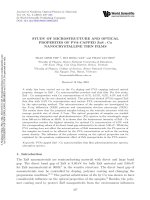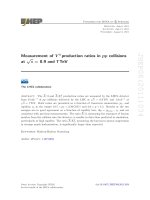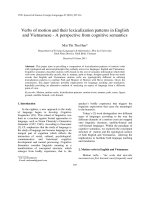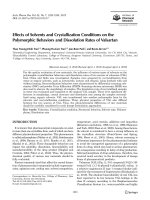DSpace at VNU: Occurrence of Perchlorate and Thiocyanate in Human Serum From E-Waste Recycling and Reference Sites in Vietnam: Association With Thyroid Hormone and Iodide Levels
Bạn đang xem bản rút gọn của tài liệu. Xem và tải ngay bản đầy đủ của tài liệu tại đây (919.02 KB, 13 trang )
Arch Environ Contam Toxicol (2014) 67:29–41
DOI 10.1007/s00244-014-0021-y
Occurrence of Perchlorate and Thiocyanate in Human Serum
From E-Waste Recycling and Reference Sites in Vietnam:
Association With Thyroid Hormone and Iodide Levels
Akifumi Eguchi • Tatsuya Kunisue •
Qian Wu • Pham Thi Kim Trang • Pham Hung Viet
Kurunthachalam Kannan • Shinsuke Tanabe
•
Received: 23 October 2013 / Accepted: 18 March 2014 / Published online: 10 April 2014
Ó Springer Science+Business Media New York 2014
Abstract Perchlorate (ClO4-) and thiocyanate (SCN-)
interfere with iodide (I-) uptake by the sodium/iodide symporter, and thereby these anions may affect the production of
thyroid hormones (THs) in the thyroid gland. Although
human exposure to perchlorate and thiocyanate has been
studied in the United States and Europe, few investigations
have been performed in Asian countries. In this study, we
determined concentrations of perchlorate, thiocyanate, and
iodide in 131 serum samples collected from 2 locations in
Northern Vietnam, Bui Dau (BD; electrical and electronic
waste [e-waste] recycling site) and Doung Quang (DQ; rural
site) and examined the association between serum levels of
these anions with levels of THs. The median concentrations
of perchlorate, thiocyanate, and iodide detected in the serum
of Vietnamese subjects were 0.104, 2020, and 3.11 ng mL-1,
respectively. Perchlorate levels were significantly greater in
serum of the BD population (median 0.116 ng mL-1) than
those in the DQ population (median 0.086 ng mL-1), which
A. Eguchi Á T. Kunisue Á S. Tanabe
Center for Marine Environmental Studies, Ehime University,
Bunkyo-cho 2-5, Matsuyama 790-8577, Japan
T. Kunisue (&)
Faculty of Agriculture, Tottori University, 4-101 Koyamaminami, Tottori 680-8553, Japan
e-mail:
Q. Wu Á K. Kannan
New York State Department of Health and Department of
Environmental Health Sciences, School of Public Health,
Wadsworth Center, State University of New York at Albany,
P.O. Box 509, Albany, NY 12201-0509, USA
P. T. K. Trang Á P. H. Viet
Center for Environmental Technology and Sustainable
Development, Hanoi University of Science, 334 Nguyen Trai,
Hanoi, Vietnam
indicated greater exposure from e-waste recycling operations
by the former. Serum concentrations of thiocyanate were not
significantly different between the BD and DQ populations,
but increased levels of this anion were observed among
smokers. Iodide was a significant positive predictor of serum
levels of FT3 and TT3 and a significant negative predictor of
thyroid-stimulating hormone in males. When the association
between serum levels of perchlorate or thiocyanate and THs
was assessed using a stepwise multiple linear regression
model, no significant correlations were found. In addition to
greater concentrations of perchlorate detected in the e-waste
recycling population, however, given that lower concentrations of iodide were observed in the serum of Vietnamese
females, detailed risk assessments on TH homeostasis for
females inhabiting e-waste recycling sites, especially for
pregnant women and their neonates, are required.
Perchlorate (ClO4-) is an anionic compound, and its salts
are used as oxidizing agents in rocket propellants, explosives, and fireworks and as dopant materials in the production of polyvinyl chloride (PVC) (Interstate Technology
and Regulatory Council 2005). Perchlorate also occurs
naturally in some fertilizers (Urbansky et al. 2001), and is
presumably generated in the atmosphere (Rao et al. 2010).
It has been reported in the United States that such sources
and high-hydrophilic property of perchlorate led to the
widespread presence of this anion in the aquatic environment and in drinking water (Blount et al. 2010). In addition, perchlorate has been detected in some food items and
vegetables (Sanchez et al. 2005). Therefore, studies performed in the United States have shown that perchlorate is
found in various human bodily fluids such as urine (Blount
et al. 2006), breast milk (Kirk et al. 2007), saliva (Oldi and
Kannan 2009), and blood (Oldi and Kannan 2009; Blount
123
30
et al. 2009). Nevertheless, few studies on human exposure
to perchlorate are available in Asian countries where perchlorate salts are produced and used.
It is known that thiocyanate (SCN-) is formed by way
of the detoxification process of hydrogen cyanide contained in cigarette smoke (Tuncel et al. 1994). This anionic
compound is also a metabolite of cyanogenic glucosides
present in plant foods such as cabbage, broccoli, and
mustard (VanEtten et al. 1969; Foss and Lund-Larsen
1986; Bertelsen and Hegedus 1994). Thus, it is thought that
intake of cigarette smoke and plant foods is a main exposure source of thiocyanate for humans. In Europe and the
United States, the detection of thiocyanate in human urine
and serum has been reported (Foss and Lund-Larsen 1986;
Blount et al. 2006).
Iodide (I-) is essential for the production of thyroid
hormones (THs) (Bianco et al. 2002). Both perchlorate
and thiocyanate can competitively inhibit iodide uptake by
the thyroid gland (TG) by way of the sodium/iodide (Na?/
I-) symporter (NIS) consequently decreasing the synthesis
of tri-iodothyronine (T3) and thyroxine (T4) (Tonacchera
et al. 2004; Dohan et al. 2007). The United States
National Academy of Sciences and the United States
Environmental Protection Agency (USEPA) have adopted
an oral reference dose (RfD) of 0.7 mg perchlorate/kg
body weight (bw)/d based on a study of inhibition of
iodide uptake by perchlorate into the TG (Greer et al.
2002; Zewdie et al. 2010). Exposure to perchlorate was
associated with increased serum TSH levels in adult
women with urinary iodine levels \100 lg L-1 (Blount
et al. 2006). It was also shown that concentrations of T3
and T4 decreased significantly in TG and serum of rats
coadministered with perchlorate and an iodide-deficient
diet (Kunisue et al. 2010, 2011a). Although no RfD for
thiocyanate is available, an in vivo study has shown that a
single dose of thiocyanate to pregnant mice led to
decreased concentrations of free T3 and T4 and to
increased concentrations of TSH in plasma of their pups,
which was associated with decreased iodine levels in the
pup TG (Ghorbel et al. 2008). Thus, the adverse effects of
these two anions on TH homeostasis can be exacerbated
under iodide-deficient conditions.
In Vietnam, it was reported that urinary concentrations
of iodine in school-aged children were in the range of
20–49 lg L-1, \100 lg L-1, indicating insufficient iodide
intake by this population (de Benoist et al. 2008; Zimmermann et al. 2008). Considering the above-mentioned
information, it is likely that Vietnamese people may be at
high risk of TH disruption by perchlorate and thiocyanate;
however, human exposure to these anions has been never
investigated in this country. In addition, primitive methods
of recycling of electrical and electronic wastes (e-wastes)
in Vietnam have raised considerable concern because
123
Arch Environ Contam Toxicol (2014) 67:29–41
hazardous substances, such as heavy metals and persistent
organohalogen compounds (Silicon Valley Toxics Coalition and Basel Action Network 2002), can be released into
the environment. Our research group recently suggested
that Vietnamese workers in an e-waste site are occupationally exposed to polychlorinated biphenyls and polybrominated diphenyl ethers during recycling activities (Tue
et al. 2010). Given that perchlorate is contained in PVC and
lithium-ion batteries as a dopant material, it is probable that
residents and workers in such e-waste recycling sites are
exposed to this anion.
The present study was aimed at determining the serum
concentrations of perchlorate and thiocyanate in residents
at an e-waste recycling site and a rural reference site in
Northern Vietnam. We examined the relationship between
serum concentrations of THs and perchlorate/thiocyanate,
to assess the effects of these anions on TH homeostasis in
the Vietnamese population.
Materials and Methods
Chemicals and Devices
Ammonium perchlorate ([99.9 %) and methylamine (40
weight % solution in water) were purchased from SigmaAldrich (St. Louis, Missouri, USA). Potassium iodide and
thiocyanate solutions ([99.5 %) were from AccuStandard
Inc (New Haven, Connecticut, USA). Isotopically labelled
sodium perchlorate (Cl18O4-, [90 %) and potassium
thiocyanate (S13CN-, [95 %) were purchased from Cambridge Isotope Laboratories (Andover, Massachusetts,
USA). Vivaspin 2 centrifugal-filtration devices (CFDs)
were obtained from Sartorius Stedim Biotech (Goettingen,
Germany).
Samples
Human serum samples (n = 131) were collected from 50
males and 81 females age 10–64 years in Bui Dau (BD,
e-waste recycling site, n = 83) and Duong Quang (DQ,
rural site, n = 48), Vietnam, during January 2010 to January 2011 (Fig. 1). These 131 donors were informed
beforehand about the purpose of the study at local government health stations where volunteers registered their
consent to participate, and they consented to participation
in our study. All of the participants were randomly selected
without arbitrary criteria.
Informed consent was obtained from all 131 donors, and
this study was approved by the Ethical Committee of Ehime
University, Japan. Age, body mass index (BMI), living site,
and health conditions (smoking habits, dietary habits, and
Arch Environ Contam Toxicol (2014) 67:29–41
31
Fig. 1 Map of Vietnam
showing serum sampling
locations
Table 1 Cohort characteristics
and demographics of the
Vietnamese populations from
e-waste recycling and rural sites
Characteristics and
demographics
All participants
(n = 131)
E-waste recycling
workers (n = 83)
Residents in
reference site
(n = 48)
Age (year)
36.2 ± 12.2
35.0 ± 13.4
37.0 ± 11.5
2
BMI (kg/m )
20.4 ± 2.47
20.3 ± 2.50
20.4 ± 2.47
Male
Female
50 (38 %)
81 (62 %)
35 (42 %)
48 (58 %)
15 (30 %)
33 (70 %)
Pregnant
4 (4.9 %)
2 (4.2 %)
2 (6.1 %)
Smokera
30 (23 %)
23 (28 %)
7 (15 %)
1–3 times/week
58 (44 %)
37 (45 %)
21 (44 %)
4–6 times/week
73 (56 %)
46 (55 %)
27 (56 %)
0 times/week
119 (91 %)
79 (95 %)
40 (83 %)
1–3 times/week
12 (9 %)
4 (5 %)
8 (17 %)
1–3 times/week
24 (18 %)
19 (23 %)
5 (10 %)
4–6 times/week
107 (82 %)
64 (77 %)
43 (90 %)
131 (100 %)
83 (100 %)
48 (100 %)
Fish consumption
Freshwater fish
Marine fish
Meat consumption
Vegetable consumption
a
No females were smokers
[6 times/week
pregnancy status) were recorded by interview with the participants, and these data are listed in Table 1. The interview
was performed by volunteers from the Center for Environmental Technology and Sustainable Development, Hanoi
University of Science, according to a standardized questionnaire. Whole blood samples were collected by a certified
physician, and serum samples were obtained by way of
centrifugation after heparin treatment, frozen in liquid
nitrogen, transported to Japan, and stored at -25 °C or
-80 °C in the Environmental Specimen Bank (es-Bank) of
Ehime University (Tanabe 2006) until analysis.
Analysis of Perchlorate, Thiocyanate, and Iodide
Perchlorate, thiocyanate, and iodide were analyzed
according to the procedures reported previously (Oldi and
Kannan 2009; Zhang et al. 2010). Each serum sample was
thawed at room temperature, and an aliquot of 0.5 mL was
transferred to a Vivaspin 2 CFD. Two hundred microliters
of an internal standard mixture containing 0.1 ng (100 lL
[1 ng mL-1]) of Cl18O4- and 10 ng (100 lL
[100 ng mL-1]) of S13CN- and 300 lL of Milli-Q water
were added. The diluted sample was vortexed to
123
32
incorporate the internal standard into the sample matrix.
The Vivaspin 2 CFD was then centrifuged for 30 min at
4,0009g. The filtrate was transferred to a sample vial for
the following instrumental analysis.
Instrumental Analysis
The instrumental analysis was performed using an Agilent
1100 Series high-performance liquid chromatograph (Agilent Technologies, Santa Clara, California, USA) coupled
with a Micromass Quattro LC tandem mass spectrometer
(Waters, Milford, Massachusetts, USA). One hundred
microliters of the filtrate were injected using a Gilson 215
liquid handler (Gilson, Middleton, Wisconsin, USA) and a
Gilson 819 injection module equipped with a 100-ll
injection loop. Separation of perchlorate, iodide, and
thiocyanate in the sample was performed using an IonPac
AS-21 column (guard column 50 mm 9 2 mm, regular
column 250 mm 9 2 mm; Dionex, Sunnyvale, California,
USA). An isocratic mobile phase of 200 mM aqueous
methylamine was used at a flow rate of 0.3 mL/min.
Electrospray negative ionization was employed in the
multiple reaction monitoring mode with the following mass
transitions to identify and quantify perchlorate, Cl18O4-,
thiocyanate, S13CN-, and iodide: 99 (35ClO4-) [ 83
(35ClO3-), 101 (37ClO4-) [ 85 (37ClO3-), 107
(35Cl18O4-) [ 89 (35Cl18O3-), 58 (SCN-) [ 58 (SCN-),
59 (S13CN-) [ 59 (S13CN-), and 127 (127I-) [ 127
(127I-). Relative responses of the native standard to the
isotope-labeled internal standard and the ratios of 35Cl to
37
Cl (for perchlorate) were used for the confirmation of
target analytes. The ratios (35Cl:37Cl) were considered
acceptable at 3.12 (± 25 %). Data acquisition and calculation were accomplished using Micromass MassLynx 3.5
(Waters).
Quality Assurance and Quality Control
Recoveries of internal standards Cl18O4-and S13CN- spiked
into serum samples (n = 131) were in the range of 60–110 %
and 88–135 %, respectively. A 10-point calibration standard
(in Milli-Q water) comprising concentrations ranging from
0.01 to 50 ng mL-1 for perchlorate, 2–2,000 ng mL-1 for
thiocyanate, and 0.02–100 ng mL-1 for iodide were injected
with each batch of 30 samples. The regression coefficients
for calibration curves were[0.999 for all target analytes. A
laboratory reagent blank and an instrument blank were run
with each batch of samples. Blanks contained trace levels of
iodide, which were subtracted from concentrations of iodide
detected in samples. The limits of quantitation (LOQs) for
perchlorate, thiocyanate, and iodide in serum samples were
0.05, 0.5, and 0.5 ng mL-1, respectively.
123
Arch Environ Contam Toxicol (2014) 67:29–41
Perchlorate-Equivalent Concentration
An in vitro study using Chinese hamster ovary cells expressing human NIS reported that the relative potency of ClO4- to
inhibit 125I- uptake by the NIS was 15 times greater than that
of SCN- on a molar basis (Tonacchera et al. 2004). Based on
the potency factor, we calculated perchlorate-equivalent
concentrations (PECs) in serum sample, using the following
formula: PEC (lmol L-1) = [ClO4-] (lmol L-1) ?
[SCN-] (lmol L-1)/15.
TH Analysis
Concentrations of THs in serum were analyzed by electrochemiluminescence immunoassay method as described in our
previous study (Kunisue et al. 2011b). TSH, total T3 (TT3),
total T4 (TT4), free T3 (FT3), and free T4 (FT4) were measured
using Elecsys kits (Roche Diagnostics, Mannheim, New
York, USA) and Modular Analytics E170 systems (Hitachi,
Tokyo, Japan). The expected reference intervals in euthyroid
humans are within 0.270–4.2 lIU mL-1 for TSH, 0.80
–2.0 ng mL-1 for TT3, 45–117 ng mL-1 for TT4, 2.0
–4.4 pg mL-1 for FT3, and 9.7–17 pg mL-1 for FT4 (Roche
Diagnostics GmbH 2008).
Statistical Analysis
Statistical analyses were performed using R program
Version 2.15.1. with its graphical user interface EZR
(Saitama Medical Center, Jichi Medical University, The R
Foundation for Statistical Computing, version 2.13.0)
(Kanda 2013). This interface is a modified version of the R
commander (version 1.6-3) and is designed to add frequently used biostatistical functions. Steel–Dwass test
(Kruskal–Wallis post hoc test) was used to assess differences in serum concentrations of anions and THs between
the residents of e-waste recycling and reference sites or
among females, nonsmoking males, and smoking males.
Spearman’s rank correlation coefficients were calculated to
assess the strength of relationships between serum concentrations of each anion and age or BMI of the donors.
Associations between serum levels of THs and perchlorate,
thiocyanate, or iodide were assessed using a stepwise
multiple linear regression model. The normality of distribution for each parameter was assessed by Shapiro–Wilk
test. Although the data for TT4 and FT4 were normally
distributed in serum, the concentrations of TSH, TT3, FT3,
perchlorate, thiocyanate and iodide were not normally
distributed; hence, these data were log-transformed for the
regression analyses. Characteristics, such as age, residential area, BMI, pregnancy status, and dietary habits (meat,
freshwater, and marine fish consumption), which can
Arch Environ Contam Toxicol (2014) 67:29–41
influence TH levels, were used as explanatory variables. A
p-value of \0.05 denoted significance.
For any model, the parameters that optimize the
approximation of the likelihood can be found numerically.
Following this, the optimized likelihoods from different
models can be compared through Akaike’s information
criterion (AIC) as follows: AIC = 2k-2ln L. In this
model, k is the number of parameters, and L is the maximized likelihood. The model with the smallest AIC was
selected, thus providing a tradeoff between model complexity (preferring models with fewer parameters) and the
maximized likelihood of the model.
Results
Perchlorate
Perchlorate was detected in 129 of 131 serum samples with
the concentrations ranging from 0.050 to 1.25 ng mL-1
(median 0.104 ng mL-1), whereas the levels in two donors
were lower than the LOQ (Table 2). Serum concentrations
of perchlorate in BD (e-waste recycling site) residents
(median 0.116 ng mL-1) were significantly greater
(p \ 0.05) than those in DQ (rural site) residents (median
0.086 ng mL-1). No significant relationships were found
between serum concentrations of perchlorate and smoking,
dietary habits, sex, age, or BMI (Table 2, Fig. 2).
Thiocyanate
Thiocyanate was found in all 131 serum samples analyzed
(median 2,020 ng mL-1) (Table 2). Significantly greater
concentrations of thiocyanate were found in males (median
2,850 ng mL-1) than in females (median 1,760 ng mL-1).
It is of note among both BD and DQ residents, male
smokers had significantly greater thiocyanate levels than
did male nonsmokers (all females were nonsmokers)
(Fig. 3). No significant associations were found between
thiocyanate levels and location of sampling, dietary habits,
or BMI, but an age-dependent increase in serum concentrations of thiocyanate was observed (Fig. 2).
Iodide
Iodide was also found in all 131 serum samples analyzed in
this study (median 3.11 ng mL-1) (Table 2). Significantly
greater (p \ 0.05) concentrations of iodide were found in
the serum of males (median 3.38 ng mL-1) and those who
consumed less fish (median 3.27 ng mL-1) compared with
those of females (median: 2.91 ng mL-1) and frequent fish
eaters (median 2.49 ng mL-1). Other demographic characteristics, such as smoking, meat consumption, age, and
33
BMI, were not significantly associated with serum iodide
levels.
PEC
The PECs calculated from serum concentrations of perchlorate and thiocyanate in the Vietnamese populations
were in the range of 0.365–23.1 lmol L-1 (median
2.28 lmol L-1) (Table 2), and thiocyanate levels accounted for [99 % of the PEC values. Therefore, the associations between serum PECs and demographic characteristics
of donors were identical with the trends observed for
thiocyanate levels described previously, i.e., greater PECs
were found in males and smokers than in females and
nonsmokers.
Association of Serum TH Levels With Perchlorate,
Thiocyanate, and Iodide Concentrations
Concentrations of THs measured in Vietnamese sera are
listed in Table 3. Serum concentrations of FT3 and TT3 in
BD residents (e-waste site) were significantly lower
(p \ 0.05) than those in DQ residents (Table 3). To
examine the relationship between TH levels and concentrations of perchlorate, thiocyanate, and iodide in sera, we
used a stepwise multiple linear regression model. Because
serum concentrations of thiocyanate and iodide differed
significantly between males and females, as described
previously, subsequent analyses were separated by sex. The
multilinear regression analyses showed that iodide was a
significant positive predictor of FT3 (p \ 0.01) and TT3
(p \ 0.01) and a significant negative predictor of TSH
(p \ 0.01) in males (Table 4). In contrast, no significant
associations between serum concentrations of THs and
perchlorate, thiocyanate, or PEC were found for either
males or females.
Discussion
Perchlorate
To our knowledge, this is the first study to determine serum
levels of perchlorate in Vietnamese populations. Interestingly, serum concentrations of perchlorate in BD residents
were significantly greater than those in DQ residents
(Table 2), and the measured concentrations were comparable with those reported for Albany and New York City,
United States (Oldi and Kannan 2009); however, the levels
in BD residents were relatively lower than those reported
for New Jersey and Lansing, United States (Oldi and
Kannan 2009; Blount et al. 2009) (Fig. 4). These results
indicate the presence of perchlorate sources in the e-waste
123
34
Table 2 Serum concentrations
of perchlorate, thiocyanate, and
iodide and PEC and selected
demographic characteristics
Arch Environ Contam Toxicol (2014) 67:29–41
Concentrations and
characteristics
Perchlorate
(ng mL-1)
Thiocyanate
(ng mL-1)
Iodide
(ng mL-1)
PEC
(lmol L-1)
Total (n = 131)
Min
\0.050a
317
1.26
0.365
1st Qu
0.076
1,320
2.40
1.49
Median
0.104
2,020
3.11
2.28
3rd Qu
0.153
3,200
4.15
3.62
Max
1.25
20,100
13.1
23.1
0.365
Location
DQ (rural) (n = 48)
Min
\0.050
317
1.32
1st Qu
0.070
1,230
2.16
1.37
Median
3rd Qu
0.086
0.120
1,750
2,890
2.89
4.69
2.03
3.27
Max
0.660
20,100
13.1
23.1
0.54
BD (e-waste (n = 83)
Min
\0.050
466
1.26
1st Qu
0.085
1,410
2.61
1.58
Median
0.120
2,140
3.25
2.52
3rd Qu
0.160
3,700
3.91
4.32
1.25*
12,600
12.2
14.9
0.365
b
Max
Sex
Female (n = 81)
Min
\0.050
317
1.26
1st Qu
0.076
1,190
2.23
1.37
Median
0.106
1,760
2.91
2.03
3rd Qu
0.156
2,610
3.84
3.00
Max
1.25
8,850
7.95
10.2
Male (n = 50)
Min
0.050
772
1.46
0.889
1st Qu
0.078
1,710
2.82
1.97
Median
0.101
2,850
3.38
3.27
3rd Qu
0.139
5,790
4.32
6.66
Max
0.464
20,100**c
13.1*c
23.1**c
0.365
Habit of eating marine fish
0 times/week (n = 119)
Min
\0.050
317
1.26
1st Qu
0.077
1,330
2.44
2.41
Median
0.104
2,060
3.27
2.51
3rd Qu
0.151
3,200
4.23
3.51
Max
1.25
20,100
13.1*d
23.1
1–3 times/week (n = 12)
Min
\0.050
1,030
1.44
1.21
1st Qu
Median
0.070
0.120
1,290
1,640
2.06
2.49
1.34
1.77
3rd Qu
0.170
3,280
3.13
2.53
Max
0.278
10,800
3.52
11.3
Min
\0.050
317
1.26
0.365
1st Qu
0.077
1,330
2.44
2.41
Habit of eating freshwater fish
1–3 times/week (n = 58)
123
Arch Environ Contam Toxicol (2014) 67:29–41
Table 2 continued
35
Perchlorate
(ng mL-1)
Thiocyanate
(ng mL-1)
Iodide
(ng mL-1)
PEC
(lmol L-1)
Median
0.104
2,060
3.27
2.51
3rd Qu
0.151
3,200
4.23
3.51
Max
1.25
20,100
13.1*e
23.1
1.21
Concentrations and
characteristics
[4 times/week (n = 73)
Min
\0.050
1,030
1.44
1st Qu
0.070
1,290
2.06
1.34
Median
0.120
1,640
2.49
1.77
3rd Qu
0.170
3,280
3.13
2.53
Max
0.278
10,800
3.52
11.3
Habit of eating meat
Qu Quartile, Max Maximum,
Min Minimum
a
Lower than detection limit
b
Significantly greater than
rural site
c
Significantly greater than
females
d
Significantly greater than
marine fish eater
e
Significantly greater than
freshwater fish eater
*p \ 0.05
**p \ 0.01
1–3 times/week (n = 24)
Min
0.062
670
1.40
0.750
1st Qu
0.092
1,300
2.14
1.47
Median
0.126
1,990
3.22
2.25
3rd Qu
0.199
4,680
4.03
5.29
Max
0.464
8,930
10.1
10.1
\0.050
317
1.26
0.365
[6 times/week (n = 107)
Min
1st Qu
0.075
1,330
2.44
1.51
Median
0.100
2,060
3.10
2.33
3rd Qu
0.147
3,050
4.15
3.45
Max
1.25
20,100
13.1
23.1
recycling site and the specific exposure of BD residents to
perchlorate. Given that perchlorate is used in PVC and
lithium-ion batteries as a dopant material (Interstate
Technology and Regulatory Council 2005), BD residents
might be exposed to relatively high levels of this anion
during e-waste recycling operations.
Based on the serum concentrations of perchlorate
detected in this study, we estimated the perchlorate exposure dose for the Vietnamese populations, using the following equation, developed by Gibbs (2006), as follows:
Log E = [log(C/99.5) -1.052]/0.9193,
where E is the estimated exposure dose (mg/kg bw/d), C
is the serum perchlorate level (lg L-1), and 99.5 is the
molar mass of perchlorate. The median exposure doses of
perchlorate estimated for DQ and BD residents were
0.033 lg/kg/d and 0.048 lg/kg/d, respectively, and the
values were 1 order of magnitude lower than the USEPA
RfD of 0.7 lg/kg/d (Zewdie et al. 2010). However, the
estimated exposure dose (0.81 lg/kg/d) for an e-waste
recycling worker, who had the highest serum concentration
of perchlorate, was comparable with the USEPA RfD,
indicating that some individuals might be at risk from
perchlorate exposure. Further studies are needed to identify
hot spots in the e-waste recycling site and exposure sources
of perchlorate for BD residents in Vietnam.
Thiocyanate
Greater serum concentrations of thiocyanate in males than
in females were found (p \ 0.05). Especially at both the
BD and DQ sites, male smokers had greater levels of this
anion than did male nonsmokers and females (all females
were nonsmokers) (Fig. 3), suggesting that smoking is a
major exposure source of thiocyanate. In previous Norwegian (Foss and Lund-Larsen 1986) and Danish (Laurberg et al. 2004) studies, greater serum concentrations of
thiocyanate in smokers than in nonsmokers have been
reported (Fig. 5). In fact, it is known that thiocyanate is
formed by way of the detoxification process of the
hydrogen cyanide contained in cigarette smoke (Tuncel
et al. 1994). In this study, a significant positive correlation
between serum thiocyanate levels and donor age was
observed (Fig. 2). However, this correlation no longer
became significant after exclusion of data for smokers
(p = 0.24), whereas serum thiocyanate levels in smokers
were positively correlated with age (p \ 0.05) (data not
shown). Thus, it is probable that the age-dependent
increase in serum concentrations of thiocyanate observed
in this study (Fig. 2) is attributed to the smoking habit.
As for nonsmokers, serum concentrations of thiocyanate
were comparable with the data reported from Norway (Foss
123
36
1.2
Perchlorate (ngmL -1)
Fig. 2 Relationships between
serum anion levels and age or
BMI of Vietnamese subjects
Arch Environ Contam Toxicol (2014) 67:29–41
1.0
p = 0.055
1.2
p = 0.24
r = 0.17
1.0
r = 0.08
0.8
0.8
0.6
0.6
0.4
0.4
0.2
0.2
0.0
0.0
10
Iodide (ng mL-1)
12
10
30
40
50
60
12
r = 0.09
10
8
8
6
6
4
4
2
2
20000
15000
20
30
40
50
60
20000
r = 0.23
15000
18
20
22
24
26
20
22
24
26
20
22
24
26
p = 0.99
r = 0.01
16
p = 0.008
18
p = 0.13
r = 0.13
10000
10000
5000
5000
0
0
10
20
30
40
Age (yrs)
and Lund-Larsen 1986) and Denmark (Laurberg et al.
2004) and were greater than those reported from the United
States (Blount et al. 2009) (Fig. 5). Given that thiocyanate
is also a metabolite of cyanogenic glucosides present in
plant foods such as cabbage, broccoli, and mustard (VanEtten et al. 1969, 1976; Foss and Lund-Larsen 1986;
Bertelsen and Hegedus 1994), the differences in serum
concentrations of this anion observed between Vietnamese
and American nonsmokers may be related to the frequency
of vegetable ingestion.
Iodide
Iodide concentrations found in Vietnamese serum samples
ranged from 1.26 to 13.1 ng mL-1 (median 3.11 ng mL-1)
123
16
p = 0.32
10
Thiocyanate (ng mL-1)
20
50
60
16
18
BMI
(Table 2). Normal range of serum concentrations of iodine in
healthy subjects were defined to range from 50 to
100 ng mL-1, and approximately 5 % (2.5–5 ng mL-1) of
this form in the serum are thought to be inorganic iodine (i.e.,
95 % as organic iodine derivatives) (Wagner et al. 1961; Fisher
et al. 1965; Nagataki et al. 1967; Sternthal et al. 1980). Iodide
concentrations in 71.7 % of serum samples (n = 94) analyzed
in this study were[2.5 ng mL-1, but the levels in 28.2 %
samples (n = 37) were less than the reference value. The
World Health Organization (World Health Organization,
United Nations International Children’s Emergency Fund,
International Council for Control of Iodine Deficiency Disorders 2001) has reported that the optimal values for a population’s urinary iodine levels is in the range of 100 and
200 ng mL-1. In Vietnam, however, it was recently reported
Arch Environ Contam Toxicol (2014) 67:29–41
Female
Male Nonsmoker
b
10000
a
5000
consumption of iodized salt, although no such information
on salt intake is available for Vietnam. Considering that
serum iodide levels in the Vietnamese population were not
associated with meat consumption and were greater in
those who ate less fish (Table 2), the intake of iodideenriched food items, e.g., seaweed (Tokudome et al. 2004)
other than meat and fish may be less among Vietnamese
females.
Male smoker
b
15000
Concentrations (ng mL-1)
37
a
a
a
PEC
PECs calculated from serum concentrations of perchlorate
and thiocyanate among Vietnamese subjects ranged from
0.365 to 23.1 lmol L-1, and thiocyanate accounted for
[99 % of the PEC values. PECs observed in 84 % of the
subjects (n = 110) exceeded the IC50 (1.22 lmol L-1)
values reported for inhibition of iodide uptake in an in vitro
study using Chinese hamster ovary cells expressing human
NIS (Tonacchera et al. 2004). Recently, in the calculation
of PECs, Bruce et al. (2013) adopted a relative potency of
17.6 for thiocyanate. When we recalculated the PECs using
this value (17.6), those in 79 % of Vietnamese subjects
(n = 103) were greater than the IC50 (1.22 lmol L-1).
These results imply that the PEC in Vietnamese populations can inhibit iodide uptake into the TG. An epidemiological survey suggested that serum PEC values
6.7 lmol L-1 were associated with adverse effects on TH
homeostasis in humans under iodine-deficient conditions
(Gibbs 2006). Such differences in the threshold values
estimated between in vitro and in vivo studies are mainly
0
Rural area
E-waste site
Fig. 3 Concentrations of thiocyanate in the serum from Vietnamese
females (nonsmokers), male nonsmokers, and male smokers. Different letters (a and b) on the top of each column represent the statistical
differences by Steel–Dwass test (p \ 0.05)
that urinary concentrations of iodine in school-age children
were in the range of 20–49 ng mL-1 (de Benoist et al. 2008;
Zimmermann et al. 2008). These observations indicate that
Vietnamese people consume a relatively low amount of iodide.
In the present study, serum concentrations of iodide in
females were significantly lower than those in males
(Table 2). In fact, serum iodide levels in 35.8 % of females
(n = 28) were \2.5 ng mL-1. It has been reported that
females generally consume less (iodized) salt than do
males (Brown et al. 2009), and hence the sex difference in
iodide levels observed in this study may be attributed to the
Table 3 Concentrations of
thyroid hormones in
Vietnamese serum analyzed in
this study
Cohort
TT3 (ng mL-1)
TT4 (ng mL-1)
FT3 (pg mL-1)
FT4 (ng mL-1)
TSH (lIU mL-1)
Total (n = 131)
Min
0.50
43
2.3
0.85
0.022
1st Qu
1.1
63
3.1
1.2
1.0
Median
1.3
74
3.3
1.3
1.5
3rd Qu
1.6
83
3.5
1.4
2.2
Max
4.8
130
11
1.9
8.2
46
2.7
0.93
0.040
Location
Rural (n = 48)
Min
0.93
1st Qu
1.2
69
3.2
1.2
0.99
Median
1.3
79
3.4
1.3
1.5
3rd Qu
1.4
87
3.5
1.4
2.2
Max
4.8
130
11
1.7
8.2
43
2.3
0.85
0.022
E-waste (n = 83)
Qu Quartile, Max Maximum,
Min Minimum
a
Significantly lower than rural
site
*p \ 0.05
**p \ 0.01
Min
0.50
1st Qu
1.1
61
3.0
1.2
1.0
Median
1.2
71
3.3
1.3
1.4
3rd Qu
1.3
81
3.5
1.4
2.1
Max
2.7**a
120
8.2*a
1.9
4.6
123
38
Arch Environ Contam Toxicol (2014) 67:29–41
Table 4 Association coefficients (b) between serum concentrations of anions and THs in the Vietnamese populations by single and multiple
linear regression models
Perchloratec
Unadjusted ba
Thiocyanetec
Adjusted bb
Unadjusted b
Iodidec
Adjusted b
Unadjusted b
PECc
Adjusted b
Unadjusted b
Adjusted b
Female (n = 81)
TT4
–4.9
TTc3
FT4
FTc3
c
TSH
2.7
2.9
0.22
0.067
–0.02
0.087
0.036
0.062
0.047
–0.02
0.078
–0.18
0.042
–0.13
0.69
–0.0011
0.012
0.072
–0.0039
–0.011
Male (n = 50)
TT4
–1.8
5.1
–4.6
TTc3
0.035
0.041
0.16*
FT4
0.074
0.028
0.08
FTc3
0.011
c
TSH
–0.03
0.29
0.19**
0.0032
–0.0029
–0.01
0.14
0.16**
–0.00086
–0.04
–0.51**
–0.45**
–0.0039
Blank cell Data omitted by stepwise procedure
a
Unadjusted coefficients were calculated by single regression analysis
Coefficients were adjusted by age, BMI, pregnancy status (yes/no), living site (e-waste/reference), and habit of eating freshwater fish (1–3
times/week vs. 4 times/week), marine fish (0 times/week vs. 1–3 times/week), and meat (1–3 times/week vs. [4 times/week)
b
c
Values of TT3, FT3, TSH, perchlorate, thiocyanate, iodide, and PEC were log-transformed
* p \0.05
** p \0.01
reported that nitrate accounted for [75 % of PEC values
calculated from urinary perchlorate, thiocyanate, and
nitrate levels. Thus, the effect of exposure of Vietnamese
populations to perchlorate, thiocyanate, and nitrate on TH
homeostasis is a concern and should be the subject of
further investigation.
Associations of Serum TH Levels With Perchlorate,
Thiocyanate, and Iodide Concentrations
Fig. 4 Comparison of serum concentrations of perchlorate in Vietnamese subjects analyzed in this study with previous United States
data. 1 = Oldi and Kannan (2009); 2 = Blount et al. (2009)
due to the differences in kinetics of perchlorate and thiocyanate. Approximately 12 % of the Vietnamese subjects
(n = 16) analyzed in this study had the PECs greater than
the threshold value of 6.7 lmol L-1 reported by Gibbs
(2006).
Although nitrate was not analyzed in this study, it was
reported in the National Health and Nutrition Examination
Survey subjects (Suh et al. 2013; Bruce et al. 2013) that
this anion might have affected thyroid NIS status. Suh et al.
(2013) showed that urinary nitrate was a significantly
negative predictor of serum free T4, and Bruce et al. (2013)
123
Associations between serum levels of THs and perchlorate
and related anions were assessed using a stepwise multiple
linear regression model. No significant associations
between serum concentrations of THs and PECs were
found for either males or females (Table 4). The multiple
regression analyses for the concentrations of perchlorate
and thiocyanate individually yielded similar results
(p [ 0.05). These observations indicated that serum concentrations of perchlorate and thiocyanate in most of the
Vietnamese donors are lower than the levels that would
affect TH homeostasis. As described earlier, PECs in
87.8 % of the Vietnamese serum samples (n = 115) were
lower than the threshold value of 6.7 lmol L-1 (Gibbs
2006). In addition, an epidemiological study reported significant upregulation of TSH and downregulation of TT4 in
the serum of a population exposed to thiocyanate (mean
serum concentration of thiocyanate 13,000 ng mL-1)
Arch Environ Contam Toxicol (2014) 67:29–41
39
Fig. 5 Comparison of serum
concentrations of thiocyanate in
Vietnamese subjects analyzed in
this study with previous United
States and European data.
1 Blount et al. (2009);
2 Laurberg et al. (2004); and 3
Foss and Lund-Larsen (1986)
compared with a reference population (5,300 ng mL-1)
(Banerjee et al. 1997). Thiocyanate levels in 84.7 %
(n = 111) of the Vietnamese serum samples analyzed in
this study were \5300 ng mL-1, the mean value reported
in the reference population by Banerjee et al. (1997).
However, in light of greater concentrations of perchlorate
detected in serum from the population involved in e-waste
recycling activities and the insufficient iodide consumption
by Vietnamese females, detailed risk assessments for
females inhabiting e-waste recycling sites, especially
pregnant women and their neonates, are required.
In this study, significant positive correlations of FT3
(p \ 0.01) and TT3 (p \ 0.01), as well as a significantly
negative correlation of TSH (p \ 0.01) with serum iodide
levels, were found for males but not females with low
iodide levels, indicating that the amount of iodide uptake
was related to the synthesis of T3. However, no significant correlations were found between serum concentrations of iodide and T4 or FT4 levels (Table 4). Although
the reason is unclear, it is possible that the above-mentioned phenomenon is attributed to the deiodination of T4
to T3 by deiodinases in tissues and subsequent secretion
of iodide into the bloodstream (Greenspan & Forsham
1983).
The above-mentioned analyses had limitations, such as
sample sizes and potential covariates, i.e., donor characteristics, investigated, and hence more comprehensive surveys
using larger sample sets and potential covariates are required
to assess in detail the health effects of these anions.
In summary, we determined serum concentrations of
perchlorate and thiocyanate and examined their associations with TH homeostasis in Vietnamese populations for
the first time. Interestingly, greater concentrations of perchlorate were found in serum from a population residing in
an e-waste recycling site than in a reference rural sit,
located in Northern Vietnam. Although the serum concentrations of thiocyanate were not significantly different
between the two populations, increased levels of this anion
were observed for smokers. Perchlorate and thiocyanate
levels detected in the Vietnamese populations were not
correlated with serum concentrations of THs, and most of
the subjects had anion levels lower than the threshold
values for toxic effects as reported previously in epidemiological studies. However, given that perchlorate exposure
doses estimated for e-waste recycling workers exceeded
the USEPA RfD, and given that lower concentrations of
iodide were observed in Vietnamese females, detailed
investigations on exposure sources for females, especially
pregnant women inhabiting e-waste recycling sites, as well
as health effects in their offspring are needed.
Acknowledgments This study was supported by Grants-in-Aid for
Scientific Research (S) (No. 20221003) and (A) (No. 25257403) from
the Japan Society for the Promotion of Science (JSPS), Japan and by
the Global Center of Excellence (COE) Program from the Ministry of
Education, Culture, Sports, Science and Technology, Japan (MEXT).
We also acknowledge the JSPS Research Fellowships for Young
Scientists (DC1 and PD) in Japan (No. 22-6331, No. 25-6617) provided to A. Eguchi.
References
Banerjee KK, Marimuthu P, Bhattacharyya P, Chatterjee M (1997)
Effect of thiocyanate ingestion through milk on thyroid hormone
homeostasis in women. Br J Nutr 78:679–681
Bertelsen JB, Hegedus L (1994) Cigarette smoking and the thyroid.
Thyroid 4:327–331
Bianco AC, Salvatore D, Gereben B, Berry MJ, Larsen PR (2002)
Biochemistry, cellular and molecular biology, and physiological
roles of the iodothyronine selenodeiodinases. Endocr Rev 23:38–89
Blount BC, Pirkle JL, Osterloh JD, Valentin-Blasini L, Caldwell KL
(2006) Urinary perchlorate and thyroid hormone levels in
123
40
adolescent and adult men and women living in the United States.
Environ Health Perspect 114:1865–1871
Blount BC, Rich DQ, Valentin-Blasini L, Lashley S, Ananth CV,
Murphy E et al (2009) Perinatal exposure to perchlorate.
thiocyanate, and nitrate in New Jersey mothers and newborns.
Environ Sci Technol 43:7543–7549
Blount BC, Alwis KU, Jain RB, Solomon BL, Morrow JC, Jackson
WA (2010) Perchlorate, nitrate, and iodide intake through tap
water. Environ Sci Technol 44:9564–9570
Brown IJ, Tzoulaki I, Candeias V, Elliott P (2009) Salt intakes around
the world: Implications for public health. Int J Epidemiol
38:791–813
Bruce MG, Corey ML, Mandel HJ, Pleus CR (2013) urinary nitrate,
thiocyanate, and perchlorate and serum thyroid endpoints based
on NHANES 2001 to 2002. J Occup Environ Med 55:52–58
de Benoist B, McLean E, Andersson M, Rogers L (2008) Iodine
deficiency in 2007: global progress since 2003. Food Nutr Bull
29:195–202
Dohan O, Portulano C, Basquin C, Reyna-Neyra A, Amzel LM,
Carrasco N (2007) The Na?/I symporter (NIS) mediates
electroneutral active transport of the environmental pollutant
perchlorate. Proc Natl Acad Sci U S A 104:20250–20255
Fisher DA, Oddie TH, Epperson D (1965) Effect of increased dietary
iodide on thyroid accumulation and secretion in euthyroid
Arkansas subjects. J Clin Endocrinol Metab 25:1580–1590
Foss OP, Lund-Larsen PG (1986) Serum thiocyanate and smoking:
Interpretation of serum thiocyanate levels observed in a large
health study. Scand J Clin Lab Invest 46:245–251
Ghorbel H, Fetoui H, Mahjoubi A, Guermazi F, Zeghal N (2008)
Thiocyanate effects on thyroid function of weaned mice. C R
Biol 331:262–271
Gibbs JP (2006) A comparative toxicological assessment of perchlorate and thiocyanate based on competitive inhibition of iodide
uptake as the common mode of action. Hum Ecol Risk Assess
12:157–173
Greenspan FS, Forsham PH (1983) Basic & clinical endocrinology.
Lange Medical, Los Altos, CA
Greer MA, Goodman G, Pleus RC, Greer SE (2002) Health effects
assessment for environmental perchlorate contamination: The
dose response for inhibition of thyroidal radioiodine uptake in
humans. Environ Health Perspect 110:927–937
Interstate Technology & Regulatory Council (2005) Perchlorate:
Overview of issues, status, and remedial options. PERCHLORATE-1. Washington, D.C.: Interstate Technology & Regulatory Council, Perchlorate Team. Available at: http:// www.
itrcweb.org. Accessed 23 Oct 2013
Kanda Y (2013) Investigation of the freely available easy-to-use
software ‘‘EZR’’ for medical statistics. Bone Marrow Transpl
48:452–458
Kirk AB, Dyke JV, Martin CF, Dasgupta PK (2007) Temporal
patterns in perchlorate, thiocyanate, and iodide excretion in
human milk. Environ Health Perspect 115:182–186
Kunisue T, Fisher JW, Fatuyi B, Kannan K (2010) A method for the
analysis of six thyroid hormones in thyroid gland by liquid
chromatography-tandem mass spectrometry. J Chromatogr B
Analyt Technol Biomed Life Sci 878:1725–1730
Kunisue T, Eguchi A, Iwata H, Tanabe S, Kannan K (2011a)
Analysis of thyroid hormones in serum of baikal seals and
humans by liquid chromatography-tandem mass spectrometry
(LC-MS/MS) and immunoassay methods: Application of the
LC-MS/MS method to wildlife tissues. Environ Sci Technol
45:10140–10147
Kunisue T, Fisher JW, Kannan K (2011b) Modulation of thyroid
hormone concentrations in serum of rats coadministered with
perchlorate and iodide-deficient diet. Arch Environ Contam
Toxicol 61:151–158
123
Arch Environ Contam Toxicol (2014) 67:29–41
Laurberg P, Nohr SB, Pedersen KM, Fuglsang E (2004) Iodine
nutrition in breast-fed infants is impaired by maternal smoking.
J Clin Endocrinol Metab 89:181–187
Nagataki S, Shizume K, Nakao K (1967) Thyroid function in chronic
excess iodide ingestion: Comparison of thyroidal absolute iodine
uptake and degradation of thyroxine in euthyroid Japanese
subjects. J Clin Endocrinol Metab 27:638–647
Oldi JF, Kannan K (2009) Perchlorate in human blood serum and
plasma: Relationship to concentrations in saliva. Chemosphere
77:43–47
Rao B, Anderson TA, Redder A, Jackson WA (2010) Perchlorate
formation by ozone oxidation of aqueous chlorine/oxy-chlorine
species: Role of ClxOy radicals. Environ Sci Technol 44:
2961–2967
Roche Diagnostics GmbH (2008). Reference intervals for children
and adults. Elecsys thyroid test. Brochure. Available at: http://
www.katrangilab.org/UploadFolder/Files/Thyroid%20Reference%
20data%20Roche.pdf. Accessed 10 Mar 2014
Sanchez CA, Crump KS, Krieger RI, Khandaker NR, Gibbs JP (2005)
Perchlorate and nitrate in leafy vegetables of North America.
Environ Sci Technol 39:9391–9397
Silicon Valley Toxics Coalition and Basel Action Network (2002)
Exporting harm: The high-tech trashing of Asia. Available at: http://
ban.org/E-waste/technotrashfinalcomp.pdf. Accessed 23 Oct 2013
Sternthal E, Lipworth L, Stanley B, Abreau C, Fang SL, Braverman
LE (1980) Suppression of thyroid radioiodine uptake by various
doses of stable iodide. N Engl J Med 303:1083–1088
Suh M, Abraham L, Hixon GJ, Proctor MD (2013) The effects of
perchlorate, nitrate, and thiocyanate on free thyroxine for
potentially sensitive subpopulations of the 2001-2002 and
2007-2008 National Health and Nutrition Examination Surveys.
J Expo Sci Environ Epidemiol. doi:10.1038/jes.2013.67
Tanabe S (2006) Environmental specimen bank in Ehime University
(es-BANK), Japan for global monitoring. J Environ Monit
8:782–790
Tokudome S, Tokudome Y, Goto C, Suzuki S, Moore MA (2004)
Seaweed as a beneficial iodine food source. Asian Pac J Cancer
Prev 5:89
Tonacchera M, Pinchera A, Dimida A, Ferrarini E, Agretti P, Vitti P
et al (2004) Relative potencies and additivity of perchlorate,
thiocyanate, nitrate, and iodide on the inhibition of radioactive
iodide uptake by the human sodium iodide symporter. Thyroid
14:1012–1019
Tue NM, Sudaryanto A, Minh TB, Isobe T, Takahashi S, Viet PH et al
(2010) Accumulation of polychlorinated biphenyls and brominated flame retardants in breast milk from women living in
Vietnamese e-waste recycling sites. Sci Total Environ
408:2155–2162
Tuncel N, Aydin Y, Tikiz H (1994) The effect of three products of
cigarette smoke (cyanide, thiocyanate and nicotine) on the
concentration-response curves of 5-hydroxytryptamine, norepinephrine and epinephrine in the isolated human umbilical veins
and arteries. Pharmacol Toxicol 74:84–88
Urbansky ET, Brown SK, Magnuson ML, Kelty CA (2001) Perchlorate levels in samples of sodium nitrate fertilizer derived from
Chilean caliche. Environ Pollut 112:299–302
VanEtten CH, Daxenbichler ME, Wolff IA (1969) Natural glucosinolates (thioglucosides) in foods and feeds. J Agric Food Chem
17:483–491
VanEtten CH, Daxenbichler ME, Williams PH, Kwolek WF (1976)
Glucosinolates and derived products in cruciferous vegetables.
Analysis of the edible part from twenty-two varieties of cabbage.
J Agric Food Chem 24:452–455
Wagner HN Jr, Nelp WB, Dowling JH (1961) Use of neutron
activation analysis for studying stable iodide uptake by the
thyroid. J Clin Invest 40:1984–1992
Arch Environ Contam Toxicol (2014) 67:29–41
World Health Organization, United Nations International Children’s
Emergency Fund, International Council for Control of Iodine
Deficiency Disorders (2001) Assessment of iodine deficiency
disorders and monitoring their elimination. World Health
Organization, Geneva, Switzerland
Zewdie T, Smith CM, Hutcheson M, West CR (2010) Basis of the
Massachusetts reference dose and drinking water standard for
perchlorate. Environ Health Perspect 118:42–48
41
Zhang T, Wu Q, Sun HW, Rao J, Kannan K (2010) Perchlorate and
iodide in whole blood samples from infants, children, and adults
in Nanchang, China. Environ Sci Technol 44:6947–6953
Zimmermann MB, Jooste PL, Pandav CS (2008) Iodine-deficiency
disorders. Lancet 372:1251–1262
123
